Rosemary Plant Care: How to Grow This Aromatic Herb Indoors and Out
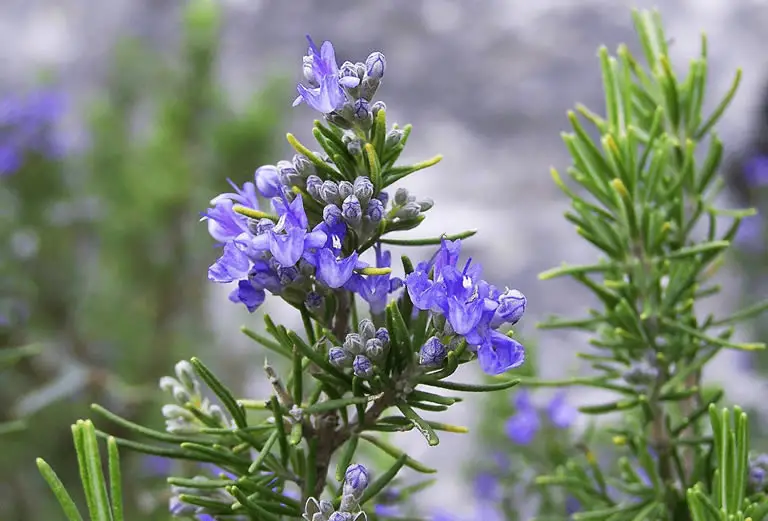
Rosemary (Salvia rosmarinus) is more than just a culinary staple—it’s an attractive, aromatic evergreen shrub that thrives with the right care both indoors and outdoors. Known for its fragrant needle-like leaves and delicate blue flowers, rosemary adds flavor to your cooking and beauty to your garden or windowsill.
Originally native to the Mediterranean, rosemary loves sun, warmth, and well-drained soil. While it’s often grown outdoors as a hardy shrub, it also does well indoors when placed in a sunny spot with good airflow.
Here’s everything you need to know to grow healthy rosemary year-round—whether you’re harvesting sprigs for your roast potatoes or just enjoying its pine-like scent at home.
Table of Contents
- What Makes Rosemary Unique
- Light Needs: Bright and Direct
- Watering: Drought-Tolerant but Not Bone-Dry
- Soil and Potting: Drainage Is Key
- Fertilizer: Feed Lightly in Spring and Summer
- Pruning and Maintenance: Keeps It Compact and Aromatic
- Best Spot in the Home
- Outdoor Rosemary Care
- Popular Rosemary Varieties
- Common Problems and Fixes
- Final Thoughts
What Makes Rosemary Unique
Rosemary is a perennial herb that belongs to the mint family (Lamiaceae), though its look and scent are more like pine than peppermint.
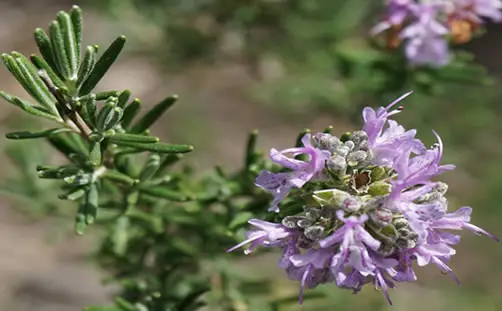
It’s native to dry, coastal hillsides around the Mediterranean and is built to withstand heat, drought, and poor soils.
This woody-stemmed plant grows upright or in a spreading, trailing form depending on the variety. In the garden, rosemary can grow into a medium-sized shrub.
Indoors, it stays compact and manageable with pruning.
Its distinctive scent comes from aromatic oils in the leaves—making it popular in perfumes, essential oils, and herbal remedies.
Light Needs: Bright and Direct
Rosemary thrives in full sun. Outdoors, it should get at least 6 to 8 hours of direct sunlight daily. Indoors, a south-facing window is ideal.
If your rosemary isn’t getting enough light indoors, it may grow leggy or stop producing new leaves.
In that case, supplement with a grow light to keep it bushy and productive.
Watering: Drought-Tolerant but Not Bone-Dry
Rosemary prefers to dry out slightly between waterings.
Water when the top inch of soil is dry, but don’t let it completely dry out for long—especially indoors where airflow is lower.
Use the soak and dry method: water thoroughly until water drains out the bottom, then allow the top layer of soil to dry before watering again.
Outdoors, rosemary usually doesn’t need watering once established—unless there’s an extended dry spell.
Indoors, check the soil every few days, especially in winter when heating systems can dry it out quickly.
Soil and Potting: Drainage Is Key
Rosemary hates soggy roots.
Use a well-draining, sandy mix—ideally a cactus or herb blend.
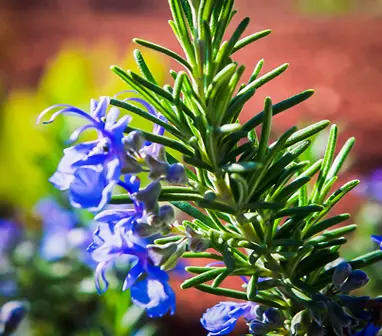
You can also make your own by combining:
-
2 parts potting mix
-
1 part coarse sand
-
1 part perlite or pumice
Always use a pot with drainage holes and avoid heavy clay soils or plastic containers that trap moisture.
When growing outdoors, plant rosemary in raised beds or mounds if your soil retains too much water.
Fertilizer: Feed Lightly in Spring and Summer
Rosemary is a light feeder.
For best results, fertilize every 4–6 weeks during spring and early summer using a balanced fertilizer such as 10-10-10 like this one or a herb-specific blend like this one.
Avoid overfeeding, which can reduce the plant’s aroma and make growth too soft.
Organic options like fish emulsion or liquid seaweed work well and support steady growth without overstimulating the plant.
Do not fertilize in late summer or fall, as new growth may be damaged by cooler temperatures.
Pruning and Maintenance: Keeps It Compact and Aromatic
Regular pruning helps rosemary stay bushy and encourages new, flavorful growth.
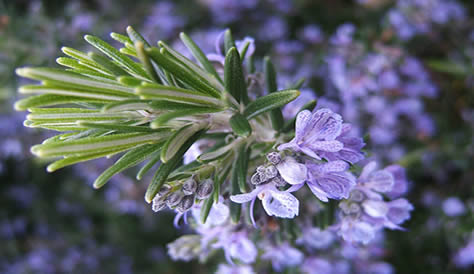
-
Trim about 2–3 inches from the tips of each stem every few weeks during active growth.
-
Avoid cutting into woody stems unless absolutely necessary—they don’t regenerate as easily.
-
After flowering, lightly shape the plant and remove any faded blooms.
If your rosemary becomes leggy indoors, give it more light and trim back weak or thin stems.
Remove any yellowing leaves or dead stems to keep the plant healthy.
Consider taking cuttings so you can propagate new lavender plants as we outlined in the article Rosemary Propagation: 4 Easy Ways to Grow More of This Fragrant Herb.
Best Spot in the Home
Indoors, rosemary grows best in a sunny kitchen window, bright living room, or heated sunroom where it gets strong light and good air circulation.
Avoid placing it near drafts, heaters, or overly humid areas like bathrooms.
In the kitchen, it’s not only decorative but also perfectly placed for snipping into your favorite dishes.
Outdoor Rosemary Care
In zones 7–11, rosemary can be grown as a perennial shrub outdoors.
Plant it in full sun with excellent drainage—preferably in raised beds, gravel gardens, or borders with sandy soil.
Space plants at least 18–24 inches apart to allow for airflow and future growth.
-
Water new plants regularly until they’re established.
-
Mulch lightly with gravel to retain warmth and prevent weeds.
-
Prune in early spring and again after flowering to shape and encourage bushy growth.
In colder climates (zones 6 and below), grow rosemary in containers that can be brought indoors before frost.
You can also treat it as an annual or overwinter it in a cool, bright room.
Popular Rosemary Varieties
There are several rosemary types, each with its own growth style and scent. Here are a few favorites:
Rosmarinus officinalis ‘Tuscan Blue’ – Upright, vigorous growth and deep blue flowers. Ideal for culinary use.
Rosmarinus officinalis ‘Arp’ – Cold-hardy and tolerant of cooler climates. Light blue flowers and a strong piney aroma.
Rosmarinus officinalis ‘Prostratus’ – A trailing variety often used in hanging baskets or cascading over walls.
Rosmarinus officinalis ‘Blue Spires’ – Tall, upright growth with lavender-blue flowers. Excellent for landscaping.
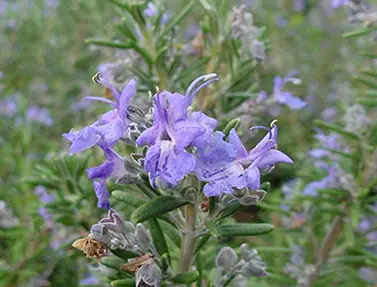
Rosmarinus officinalis ‘Golden Rain’ – Variegated leaves with golden tips. More ornamental but still edible.
Rosmarinus officinalis ‘Majorca Pink’ – Rare pink-flowered rosemary. Beautiful for borders and bee gardens.
All rosemary varieties are edible, though some have stronger flavor and scent than others.
Common Problems and Fixes
Yellowing leaves
Often a sign of overwatering or poor drainage. Check the soil and let it dry out before watering again.
Powdery mildew
Caused by poor air circulation indoors. Prune to improve airflow and avoid overhead watering.
Leggy growth
Too little light. Move to a brighter spot or add a grow light.
Root rot
Most common in heavy soil or overwatered pots. Repot in dry, well-draining soil and remove rotting roots.
Aphids or spider mites
Occasionally appear indoors. Rinse with water or spray with insecticidal soap or neem oil.
Final Thoughts
Rosemary is a rugged, sun-loving plant that adds scent, structure, and flavor to any garden or kitchen.
With its love of dry roots and full sun, it’s one of the easiest herbs to grow with just a little attention to light and watering.
Grow it indoors in a sunny kitchen, or let it thrive outdoors in a sunny, well-drained garden bed.
Either way, rosemary brings its Mediterranean charm—and that unmistakable fragrance—into your life all year long.
Thanks for reading! I'm Michael — houseplant fanatic and your Pinterest plant guide.
Follow me on Pinterest for fresh updates 🌿



